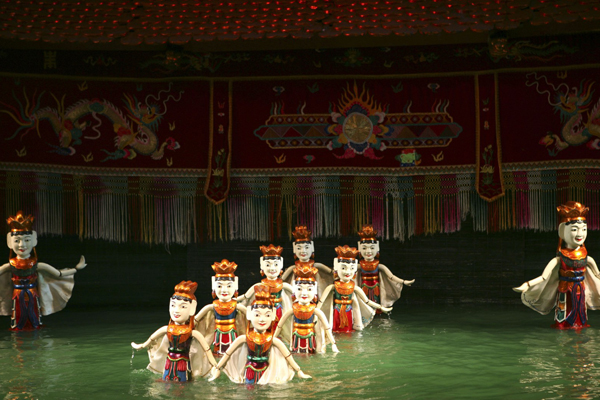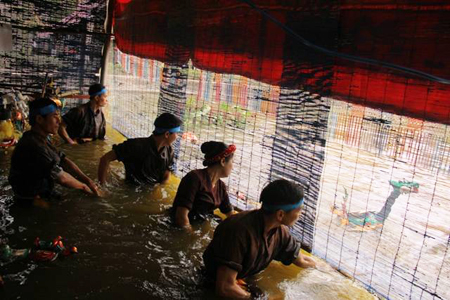The principle on which this works is the extension of mechanical control from the artist's hands in the manipulation room to the puppets on the stage by means of bamboo or wooden poles. One end of each pole is held by the artist, the other fitted in to the base...
1. The Simple Pole Mechanism
The principle on which this works is the extension of mechanical control from the artist's hands in the manipulation room to the puppets on the stage by means of bamboo or wooden poles. One end of each pole is held by the artist, the other fitted in to the base. At one end is a rotating axis by which the different standing positions of the puppet are achieved, and there is also a rudder enabling the puppet to turn easily. The manipulator pulls, pushes or sweeps the pole around to
create forward, backward or sideways movements. This is the simplest pole mechanism, with neither the limbs, head or neck of the puppet moving. The range of the movement of the puppet depends on the length of the pole (about 3.5-4.5 m).
2. The Complex Pole Mechanism
The base of the puppet is equipped with an additional may day or string mechanism, and the manipulator controls both pole and string at the same time to make the head body and limbs of the puppet move. Complex gestures can thus be achieved. The range of activity of a puppet controlled by this mechanism is not determined by a hidden framework of stakes. The complex pole mechanism is usually used for shows of sketches, stories, or to make specialized devices for a number of scenes of a show.

3. The String Mechanism (Also called soft or pulley mechanism)
The pole control system may be replaced by a string control one. Ropes are stretched between submerged stakes running from the manipulation room to the stage (and sometimes beyond the stage). A large sliding framework fitted with the puppets skims over a system of strings stretched between the stakes. The main line runs through the middle of the stage, on either side of which are other lines for specific scenes. The main line (of plaited bamboo or coconut fibre) is used only to move the sliding framework carrying the puppets. Every movement is achieved by means of the fine strings attaching the puppets to the framework. These strings, frexible but less elastic, are mace of plaited hair, coir, silk, jute or other fibres. They are also made water-resistant with a coating of wax. The string mechanism is usually used for scenes with numerous characters and lots of movement, for instance, the dance of the eight fairies and the lion dance. It is also used for larger puppets, which a pole mechanism cannot fully control, surh as Teu and the fairies. The sliding frameworks are, in certain cases, carved in the shape of boats for the boat racing scene or a naval battle scene. The techniques used to make puppets thus consist of two elements: the structure of the puppets themselves and the mechanism (both the pole and string). These two come together at the base of the puppets, which servers as a fulcrum. The base should not emerge from the water's surface, but cannot be so deeply immerse that it saps the manipulator's strength when holding and controlling either the string or the pole.
The main technical principle governing the making of puppet mechanisms is the importance of concealing the control equipment under the water. What is required of the manipulator is mechanical control from afar, taking advantage of the properties of water to move the puppets as required. Perfecting water puppet techniques comes through long experience. There are no mechanical designs or documents to help us understand this process and it is possible that some interesting scenes once able to be performed due to improved mechanism have already been lost.



